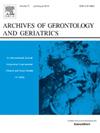ISCHEMIC STROKE AND FIBRINOGEN IN THE ELDERLY
IF 3.5
3区 医学
Q2 GERIATRICS & GERONTOLOGY
引用次数: 0
老年人缺血性卒中与纤维蛋白原的关系
衰老伴随着缺血性脑卒中患病率和发病率的显著增加。在老年人中,血浆纤维蛋白原水平随年龄的增长而增加,这与中风的发病率相似。我们研究的目的是评估老年人纤维蛋白原血浆水平的年龄相关性增加,并评估正常受试者和既往缺血性卒中伴脑前动脉粥样硬化患者之间存在的最终差异。本研究纳入80例连续入住我院老年科的住院患者(男41例,女39例)。患者组32例(男20例,女12例),年龄50-79岁,患有脑血管疾病,既往缺血性脑卒中发作1年以上。对照组48例,男21例,女27例,年龄50 ~ 79岁。对照组和患者组根据年龄又分为3个亚组:1组(50 ~ 59岁)、2组(60 ~ 69岁)和3组(70 ~ 79岁)。采用mann - whitney非参数检验进行统计比较。在正常对照中,轻微的年龄效应是明显的,因为只有第3组的纤维蛋白原水平明显高于第1组。相反,在缺血性脑卒中患者中,2组和1组之间的年龄效应已经很明显;当然,患者3组与患者1组的比较也有统计学上的显著差异。此外,2组和3组患者的纤维蛋白原水平与同龄对照组相比显著升高。我们的数据与文献中已有的数据一致,表明纤维蛋白原在正常衰老过程中随着年龄的变化而变化,在第1组和第3组之间纤维蛋白原增加19%。缺血性卒中患者比正常对照更早、更明显地显示出纤维蛋白原与年龄相关的增加。即使不可能知道纤维蛋白原升高是否是缺血性脑卒中的结果,我们也可以肯定,纤维蛋白原升高应该被视为老年人脑血管疾病的重要危险因素,值得治疗。
本文章由计算机程序翻译,如有差异,请以英文原文为准。
求助全文
约1分钟内获得全文
求助全文
来源期刊
CiteScore
7.30
自引率
5.00%
发文量
198
审稿时长
16 days
期刊介绍:
Archives of Gerontology and Geriatrics provides a medium for the publication of papers from the fields of experimental gerontology and clinical and social geriatrics. The principal aim of the journal is to facilitate the exchange of information between specialists in these three fields of gerontological research. Experimental papers dealing with the basic mechanisms of aging at molecular, cellular, tissue or organ levels will be published.
Clinical papers will be accepted if they provide sufficiently new information or are of fundamental importance for the knowledge of human aging. Purely descriptive clinical papers will be accepted only if the results permit further interpretation. Papers dealing with anti-aging pharmacological preparations in humans are welcome. Papers on the social aspects of geriatrics will be accepted if they are of general interest regarding the epidemiology of aging and the efficiency and working methods of the social organizations for the health care of the elderly.

 求助内容:
求助内容: 应助结果提醒方式:
应助结果提醒方式:


